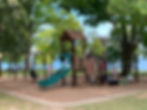Language at the Playground
- Rebecca Serafini-Dale
- Sep 8, 2021
- 2 min read
Updated: Oct 4, 2025

The playground is the perfect location to model and practice communication skills, social skills (pragmatics) and play skills. Opportunities include following directions, learning basic concepts, turn taking, using core words, requesting and even the chance to work on targeted speech sounds if built into play. Here are some examples:
Core words: These are words that can be used across a variety of contexts (i.e. more, go, different). There are even Core Word Boards popping up at playgrounds in schools and communities to be more inclusive. These boards offer visual pictures and written language to support non-verbal communicators. Focus on a word such as “different” and use it throughout the play “Oh, let’s go to a different swing” or “You’re ready for a different activity”. Pair this with American Sign Language for different. “Different” is a powerful word to decrease frustration across environments to request different food, different toy or a different book.
Different ASL

James Guido's, Learn American Sign Language (2015), Photo by Wellfleet Press
Social skills: Socializing can be tricky as you can’t always predict how a communication partner will react. For success, it is helpful to have a script and practice the script such as starting with a greeting, “Hi, I’m Joe. What’s your name?” and discussing potential get to know your questions before arriving at the park. Teach your child frequently to play park games such as tag so that they have the knowledge to jump in if they want. If your child is struggling with turn taking, start practicing
at home and role playing to prepare for the situation. “Dad’s turn to go down the slide, we have to wait for our turn”. Reading a social story about turn taking before going to the park can help prepare your child to be familiar with expectations. Be sure to take a step back and let your child trial and error, sometimes the best teachers are the peer models and problem solving.

Speech sounds: Search the playground for words that have your targeted speech sound. Pretend to be different animals that say the speech sound. For example, if working on /s/, go down the slide and pretend to be snakes making the /s/ sound while sliding!
Language: Before spoken words, there are foundational skills you can work on such as pointing to preferred playground features to make requests, imitating the bird or car sounds at the park and working on waving to greet others. One of my favorite strategies is the deliberate pause “Ready, set, ___go” or “buckle, buckle, ___snap”. During this, you are looking for the child to recognize something is going to happen or there is an expectation and eventually looking for your child to move his/her hands in anticipation or even fill in the “go”. Other language opportunities include vocabulary of basic concepts and attributes that can be labeled or incorporated with following directions. For example, “go to the big slide” or “find the bumpy wall”. Target action words such as jump, run, climb, slide.
I hope at the next playground outing, you are able to keep speech goals in mind and think of all the language opportunities! If you are looking for more ideas or have questions please e-mail me, Becca@Innovative-Speech.com. Have fun!
Rebecca Serafini-Dale, M.A. CCC-SLP